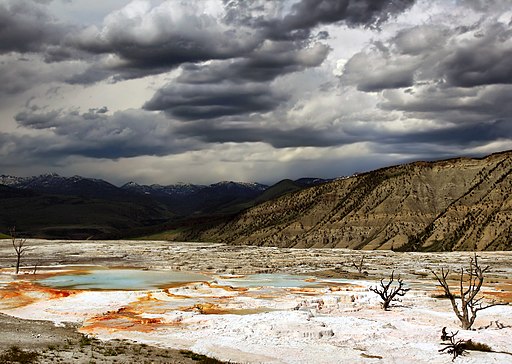
Upper Terraces of Mammoth Hot Springs, Yellowstone. By Mila Zinkova (Own work) CC-BY-SA-3.0, via Wikimedia Commons.
So, what did the paper say? Was it truly an extraordinary episode of caldera uplift? The main body of this work reported the results of a deformation survey using (GPS and InSAR) that are fairly common these days on restless volcanoes. This survey was similar to the one on Eyjafjallajörkull I have written about before, and like that survey they used computer models to try and calculate the changes beneath the caldera that would have caused the deformation observed. These models are fairly well developed, and so there is nothing controversial here.
The best fit the authors got for the deformation was an inflating sill (horizontal intrusion), along with a smaller, deflating sill. This obviously begs the question, inflating with what? The obvious answer, as this is a volcano after all, is that the sill is filling with magma, however this is not the only answer. Naples's less well know volcanic neighbour, Campi Flegrei, is well known for large inflationary events of up to 3m (compared to ~20-30cm recorded here). At Campi Flegrei the uplift is most likely related to changes in the hydrothermal system, although there is still a lot of argument over this interpretation. The original source for the deformation is still the magma chamber, but it is thought that water driven out as the magma cools is the direct cause. Inflationary events here do not necessarily reflect a fresh magma input.
So could a similar thing be happening in Yellowstone? Chang et al. do not think so. The permeable, brittle hydrothermal system at Yellowstone is shallower than about 5km, and the depth they calculated for the sill was 7-10km. They also point out that no changes to the hydrothermal system at the surface were record, as would be expected if the hydrothermal system was to blame for the uplift.
So if the intrusion was magmatic, what are the implications? Firstly, it should be pointed out that these sort of intrusions are not rare; it is frequently becoming recognised that most large intrusions are built up incrementally, one sill at a time. It is has also been shown at increasing numbers of locations that intrusion of fresh magma can trigger an eruption (something I am investigating for my PhD). However, before people get too excited about Yellowstone, intrusions frequently occur with no eruption. Why they would only sometimes trigger an eruption is still an open question.
Lastly, even if Yellowstone erupts, it would almost certainly not be in an end-of-the-world style. The vast majority of eruptions at calderas are small. In between large eruptions these systems tend to build up cones and domes, such as the many 'buttes' at Yellowstone. Chances are, the next eruption will be something similar to these, as much as that may disappoint 2012 fans.
If you enjoyed this, you can find me on Twitter, or subscribe to my RSS feed!Chang, W., Smith,
Reference:
R., Farrell, J.,&Puskas, C. (2010). An extraordinary episode of Yellowstone caldera uplift, 2004–2010, from GPS and InSAR observations Geophysical Research Letters, 37 (23) DOI: 10.1029/2010GL045451




Comments